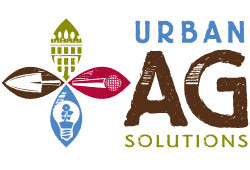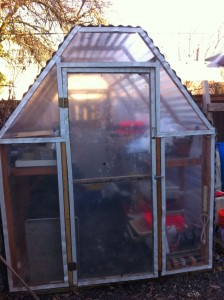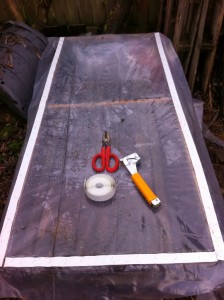I took advantage of some fine winter weather today (which in the Pac. NW could simply mean not raining, but today it was actually not merely not raining but positively sunny!) to get outside and perform some greenhouse repair. This greenhouse that you see was one of the scores of 2013. Someone I knew needed to move, had built his own sweet little greenhouse, and I swooped in and “relieved” him of it for a very good price. Had to deconstruct my back yard fence to get it in, but that was small potatoes for a nice pre-built. Anyway, it is now possible to see into the greenhouse, but when it arrived last spring, the plastic on the two ends, while still serviceable, was a milky white, and over the course of the summer it began to brittle and crack. By end of season, even a little finger poke would send flakes of plastic cascading down to the ground, and when I would try to pick up a piece, it would break again. I think the technical term for plastic pieces which break into smaller and smaller units is nurdles, which could also serve as a mild oath one might utter upon trying to pick up pieces of plastic only to have them fragment in hand and fall to the ground again as smaller and ultimately harder to pick up…”Aw, Nurdles!” Anyway, when the plastic goes to pot, it’s time to change out the whole thing, which is remarkably easy.
Here’s what you need to get the job done: some new greenhouse plastic, shears or heavy-duty scissors (not the round-tipped kiddo kind, please), a staple gun or hammer (staple hammer shown), and some cinchstrap or batten tape. First of all, I am presupposing your greenhouse is wood-framed as is mine. In the photo you can see I’ve removed the greenhouse door, laid my plastic over it, then cut the cinchstrap to fit the sides and stapled it down over the plastic, thus holding or cinching the plastic in place, which with this stuff was a cinch. Then it’s just a matter of trimming the excess plastic with the shears (or a utility knife…not shown) and popping the door back on. Of course I couldn’t take the whole greenhouse down to re-plastic it, so some was done on the structure as it stood. This stuff is so easy to work with that if you have some tools and some basic carpentry skills you can pretty much design any kind of structure you want, temporary or permanent, then tack on your plastic film, and – presto – you’ve got a custom greenhouse.
A word on supplies. Get UV treated greenhouse plastic. It’s 6 mil thick with UV inhibitors built in, so it’s guaranteed to last at least 4 years. The hardware store Visqueen stuff won’t even make it through one season, and it will crack and break like nobody’s business. If you can’t find the treated film at your local nursery or garden supply house, call up the folks at Gemplers and request their awe-inspiring farm and garden materials bible, which I guarantee you will find educational (1-800-382-8473). Luckily the tome has an index, and that’s how I found the greenhouse coverings on pages 328-9. They also have this material called batten tape, and that’s comparable to the cinchstrap I used to secure the plastic film. Some of you sharper tools in the shed may be wondering why I didn’t just staple the plastic directly to the wood. Why go to the trouble of the strapping? The narrow staple provides very little surface to hold the plastic down, so when pressure is applied to the plastic, say by the wind or by you accidently leaning into it, the plastic tends to pop right off the staples, leaving you cursing (Nurdles!!!!) and having to re-do everything.
I don’t know if you noticed this, but in the picture above, if you look toward the top of the door, there’s a condensation alien showing up. That’s creepy. Maybe it’s a spirit intent on telling me that even though plastic is easy and convenient, it’s really not ultimately sustainable and that there are gigantic patches of plastic in the oceans (always referred to as Texas-sized) where all those nurdles go to gyre around and get eaten by sea turtles and sea gulls. Maybe that spirit was sent by the sea creatures to try to steer me and others off plastic, knowing that I would be blogging about it and thus reaching a far larger audience (hopefully increasing in 2014). Maybe it’s a projection of my own divided mind about the benefits of plastic versus its costs. Hmm….I’m going to think about that. How do you interpret that face and what do you think about plastic in the garden?


